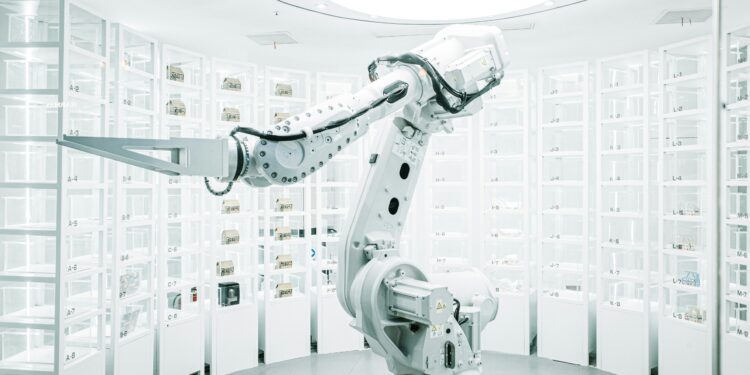Vicarious Surgical Inc. (NYSE:RBOT) is a next-generation surgical robotics company on a mission to transform the operating room through cutting-edge technology that combines advanced robotics, proprietary decoupled actuation, and immersive virtual reality. Headquartered in Waltham, Massachusetts, the company was founded in 2014 by a team of MIT engineers and healthcare innovators who envisioned a future where surgeons could perform complex procedures through a single, small incision—with enhanced precision, visualization, and dexterity unmatched by existing methods.
At the core of Vicarious Surgical’s innovation is its unique single-port robotic system. Unlike traditional laparoscopic or robotic approaches, the Vicarious platform provides a highly immersive surgical experience that allows the physician to “step inside the patient” virtually, gaining a 3D view and full articulation of their instruments inside the body. This enables minimally invasive procedures that feel like open surgery, with fewer complications, shorter recovery times, and potentially lower overall costs for patients and providers alike.
The company’s patented decoupled actuation technology allows for an unparalleled range of motion and precision within a compact surgical space. This engineering feat replicates human movement inside the abdomen and offers surgeons full visibility and control, all while requiring only a single 1.5 cm incision. It’s a technological leap forward that addresses many limitations of traditional surgical systems and has the potential to dramatically increase the accessibility and effectiveness of robotic surgery around the world.
Backed by a strong intellectual property portfolio and a visionary leadership team, Vicarious Surgical has secured strategic partnerships with leading hospital systems and institutions such as UMass Memorial Medical Center, HCA Healthcare, Intermountain Health, University Hospitals, and LSU Health New Orleans. These alliances are helping refine real-world integration and workflows in anticipation of the company’s first clinical use cases.
As Vicarious Surgical advances toward regulatory clearance and clinical trials, it stands at the intersection of healthcare innovation and technological disruption. With a vast, underpenetrated global market in surgical robotics and a solution that could set new standards for safety, precision, and patient outcomes, Vicarious Surgical is positioning itself as a future leader in the medtech space. Its evolution from concept to clinical-stage company could reshape how surgeries are performed, opening the door to a new era of robotic medicine that’s more effective, efficient, and accessible than ever before.
Q1 2025 Financials Signal Stability as the Company Approaches First Human Cases
In the first quarter of 2025, Vicarious Surgical reported a GAAP net loss of $15.4 million or $2.60 per share, a modest improvement from the $17 million loss in Q1 2024. The company beat earnings expectations slightly, reporting an EPS of -$2.60 versus the expected -$2.61. Adjusted net loss came in at $15.3 million, flat year-over-year, as the company maintained focus on product development while controlling cash burn.
Total operating expenses for the quarter were $15.7 million, representing a 2% decrease from the $16.1 million in the prior year. Research and development expenses dropped slightly to $9.4 million, while G&A and marketing remained relatively stable. Vicarious Surgical ended the quarter with approximately $37 million in cash, cash equivalents, and short-term investments. The company maintained a disciplined Q1 cash burn of $12 million and projects full-year 2025 cash usage at around $50 million.
Importantly, CFO Sarah Romano—making her first appearance since joining the company—reiterated that the company has a supportive insider base and is evaluating strategic financing options as it moves toward key clinical milestones. The emphasis on careful capital allocation paired with strong investor backing gives Vicarious ample runway to execute on its short- and mid-term goals.

CHECK THIS OUT: Lakeside Holding Limited (LSH): Key Insights and Strategic Developments and Lakeside Holding (LSH) Deepens Roots in Pharmaceutical Logistics with $1.5M Sinopharm Agreement.
Path to Clinical Trials: Inventory, Testing, and Regulatory Progress Ahead of Schedule
CEO Adam Sachs confirmed during the earnings call that the company is just a few quarters away from treating its first human patients. The company has completed key preparatory steps including building its first surgeon console and patient cart, integrating its proprietary components, and producing initial instrument sets. These components have already passed bio burden review and are undergoing critical safety testing, including sterility and biocompatibility protocols.
The next major milestone is the submission of the technical dossier to regulators in mid-2025. This document includes all essential safety, performance, and testing data that will enable the company to initiate its first clinical cases. Based on comparative timelines and regulatory expectations, Vicarious is targeting its first human procedures for late 2025. The initial endpoint for these procedures will be the successful completion of ventral hernia repairs using the V1.0 system—marking a shift from lab-controlled preclinical testing to real-world surgical deployment.
Strategic Hospital Collaborations Deepen Clinical Readiness and Market Credibility
Beyond technical progress, Vicarious Surgical is making critical strides in ecosystem development through high-value clinical partnerships. The most recent collaboration with UMass Memorial Medical Center—announced alongside Q1 earnings—is a powerful strategic move. Located near Vicarious’ Waltham HQ and affiliated with the University of Massachusetts Chan Medical School, UMass Memorial will help the company refine perioperative workflows, surgeon education programs, and best practices for operating room integration.
This partnership joins a robust list of collaborators that includes Intermountain Health, LSU Health New Orleans, HCA Healthcare, University Hospitals, and Pittsburgh CREATES. These alliances will serve as vital launchpads when the V1.0 system enters the market, ensuring that the product is not only technically ready, but also logistically and operationally viable at top-tier healthcare institutions.
CEO Sachs highlighted that the surgical robotics market remains 96% untapped white space, with massive unmet demand for systems that offer better dexterity, visualization, and efficiency. This competitive void—coupled with strong institutional enthusiasm for Vicarious’ differentiated offering—creates a highly favorable market environment for adoption.
Supply Chain Stability Reinforces Execution Capability
A question raised during the Q&A session centered around supply chain risk, a valid concern given the complexity of robotics hardware. Sachs acknowledged past challenges but confirmed that the company has experienced no recent schedule disruptions and feels confident in its ability to deliver necessary components for its next build. With a capable internal logistics team in place and a finalized prototype system in hand, Vicarious is clearly transitioning from R&D-heavy engineering into scaled production and clinical delivery.
Why Vicarious Surgical Is a High-Conviction Long-Term Bet
Vicarious Surgical is uniquely positioned at the intersection of surgical robotics, virtual reality, and AI-enhanced procedural efficiency. With its differentiated technology, experienced leadership team, and clear roadmap toward clinical validation, the company represents one of the most exciting high-risk/high-reward opportunities in medtech today. The robotic surgery market is expected to grow to over $25 billion by 2030, and Vicarious’ single-port platform offers a compelling value proposition that can capture a significant share of this growth.
Analyst sentiment remains cautiously bullish, with price targets ranging from $8.50 to $13.00 and an average target of $10.75—implying meaningful upside from current price levels. Investors should note that while the company is not yet generating commercial revenue, it has made steady operational progress, secured key partnerships, and demonstrated the fiscal discipline needed to reach its pivotal clinical milestones.
Conclusion: 2025 May Be the Year RBOT Comes to Life
The first quarter of 2025 was not just another reporting period—it marked the start of Vicarious Surgical’s transition from concept to clinical impact. With its V1.0 system nearly ready for real-world procedures, and a growing coalition of hospital partners ready to adopt and support the platform, the company is poised for a potentially transformative second half of the year.
For long-term investors willing to back visionary innovation with patience, Vicarious Surgical offers a compelling, asymmetric opportunity. With disruptive technology, operational momentum, and a massive market to penetrate, RBOT stock could be the next big name in the robotic surgery revolution.
READ ALSO: Lakeside Holding (LSH) Acquires Hupan Pharmaceutical to Enter China’s Medical Logistics Market and Lifeway Foods (LWAY): Probiotic Pioneer Targets $195M Revenue in 2024.






